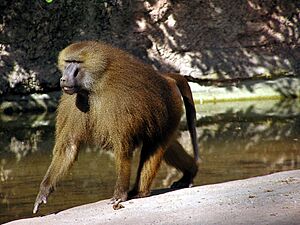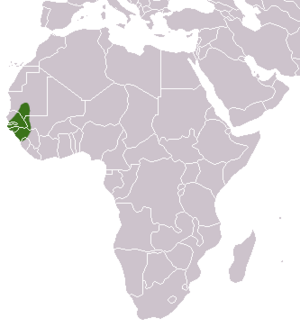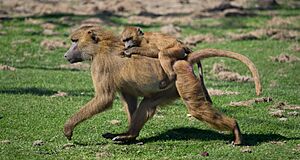Guinea baboon facts for kids
Quick facts for kids Guinea baboon |
|
|---|---|
 |
|
| Conservation status | |
| Scientific classification | |
| Genus: |
Papio
|
| Species: |
papio
|
 |
|
| Guinea baboon range | |
The Guinea baboon (Papio papio) is a type of baboon. It belongs to the Old World monkey family. Some older ways of grouping animals only listed two baboon species. The Guinea baboon was one of them. All other baboons were seen as types of this one. In those old groups, it was called the savanna baboon.
The Guinea baboon lives in a small part of western Africa. You can find it in Guinea, Senegal, Gambia, southern Mauritania, and western Mali. It lives in dry forests, gallery forests, and nearby bush savannas or steppes. This baboon has reddish-brown fur. Its face is dark-violet or black and has no hair. It has a dog-like snout with a small mane around it. Its tail curves in a round arc. Its legs are made for walking long distances on the ground. The Guinea baboon is one of the smallest baboon species. It weighs between 13 and 26 kg (28.6–57 lbs). They usually live for 20 to 50 years.
This baboon is active during the day (diurnal). It lives on the ground (terrestrial). But it sleeps in trees or on high rocks at night. This keeps it safe from predators. The number of good sleeping trees limits how big a group can be. It lives in groups of up to 200 baboons. Each baboon has a certain place in the group's order. Living in a group helps protect them from animals like lions and hyenas. Like all baboons, it eats many different things (omnivorous). It eats fruits, buds, roots, bark, grasses, greens, seeds, tubers, leaves, nuts, cereals, insects, worms, birds, and small mammals. Because it eats almost anything, the Guinea baboon can live in places with little food. Its presence can even help the habitat. It digs for water and spreads seeds in its waste. This helps new plants grow.
The Guinea baboon talks a lot with other baboons. It uses many sounds and body actions. It also makes sounds that seem meant for predators to hear. The Guinea baboon is "near threatened" by the IUCN. This is because its home area is small and its habitat is shrinking.
Contents
What Guinea Baboons Look Like
Baboons are large primates. Males and females look different in size. This is called sexual dimorphism. Females and young baboons rely on males for protection. Guinea baboons have reddish fur. Some people call them "red baboons." They have no hair on their rear ends. Their faces are black with yellow-brown sideburns. Female baboons have pink rumps. Male baboons have a mane of fur around their heads and shoulders.
Baboons have long molars and wide incisors. Their long canine teeth show that males and females are different sizes. Their front and back legs are almost the same length. Their fingers and toes are short and strong. This makes it hard for them to climb trees. Guinea baboons are among the smallest baboon species. They weigh between 13 and 26 kg (28–57 lbs).
Where Guinea Baboons Live
Guinea baboons are usually found in woodland savannas. They gather near water sources during the dry season. In the wet season, they split into smaller groups. Different baboon species usually live in separate areas. But sometimes their homes overlap. When this happens, they can sometimes breed together.
These baboons live across a wide area in Africa. They are found in savannah habitats. This includes Guinea, Senegal, Gambia, southern Mauritania, and western Mali. They mostly live in the savannahs and forests south of the Sahara Desert. You can also find them in grasslands, rainforests, and other open areas.
Daily Life and Habits
Guinea baboons are active during the day. They live on the ground. At night, they usually sleep in trees on the ends of branches. Their group size can be very different. It can range from 30 to 200 baboons. However, a common group size is 30–40 baboons.
In a group, male baboons often have a clear ranking order. They compete for mates. This competition leads to males and females being different sizes. When looking for food, they search on their own. Females often forage with males for protection. Females might choose to stay with the same males year after year.
What Guinea Baboons Eat
Like other baboon species, Guinea baboons eat any food they can find. Their main foods are fruits, roots, tubers, grass, seeds, and leaves. They also eat insects, worms, spiders, small mammals, birds, and other small creatures.
How Guinea Baboons Behave

Guinea baboons are more like Hamadryas baboons in how they live together. They live in "one-male units." Each unit has one main male, several females, and their young. Sometimes, another male might follow them. These units are usually small. But they join with other units to form a larger group called a "troop." These troops sleep or look for food together. Guinea baboon troops are large. They have many males and females, with 50–300 baboons. The main male's group (harem) has two to five females. These females mate with the main male.
Even with these similarities, Guinea baboons act a bit differently from Hamadryas baboons. Male Guinea baboons are not as strict as Hamadryas males. Female Guinea baboons also play a more active role in leading the group. Males are also very tolerant of each other. There is little fighting among them. It's unusual for baboons, and Old World monkeys, but Guinea baboons also share food.
Guinea baboon groups are very flexible. Female baboons sometimes spend long times away from males. They form temporary groups with only females. Several males might also gather and work together with little arguing. This flexible behavior has made some people compare Guinea baboon behavior to early human ancestors.
Males often use friendly actions to reduce fighting between them. This helps them cooperate. It allows troops to grow large and adapt to different situations. Hamadryas baboon males force females to join their groups. They might even bite their necks to make them stay close. But female Guinea baboons choose males freely. Males usually use facial expressions and gestures to guide females. They also groom females to gain their loyalty.
Male Guinea baboons are less strict with their female partners than Hamadryas males. Female Guinea baboons can be friendly with females from other groups. They can even be friendly with other males without being punished by their main male. Females approach males to start mating whenever they want. They might even mate with more than one male. However, they mate most often with their main male. Competition for females among males is much less or even absent.
Unlike Hamadryas baboons, Guinea baboons are not very good climbers. They prefer trees for sleeping, not high rocks or cliffs. The main males sleep on the thicker branches near the tree trunk. Lower-ranking baboons and young ones sleep on smaller, weaker branches further out. During the day, they spend most of their time looking for food on the ground. They run on all four limbs.
How Guinea Baboons Communicate
Guinea baboons use many ways to talk to each other. They use sounds, body language, and touch. Their different calls carry many messages. These include warnings about predators, showing friendly feelings, calls to show they are giving up, and sounds of anger or frustration. Many of these calls can be used with each other. They can also be used with body language or touch. Body language serves many of the same purposes as vocal calls. It is often used with a sound. Lower-ranking animals make an "ack ack" sound to calm down more dominant ones. They make "wahoo" alarm calls if they see a threat. Communication by touch is usually linked to body language. It can range from mouth-to-mouth touching to biting or slapping.
Reproduction and Life Cycle
The mother carries the baby for about six months. Nursing continues until the baby is about six to eight months old. Females will push away a male's advances by shrieking at him. They often climb up a tree to get away.


